Activity-Induced Synaptic Structural Modifications by an Activator of Integrin Signaling at the Drosophila Neuromuscular Junction
- PMID: 28219985
- PMCID: PMC5373117
- DOI: 10.1523/JNEUROSCI.3128-16.2017
Activity-Induced Synaptic Structural Modifications by an Activator of Integrin Signaling at the Drosophila Neuromuscular Junction
Abstract
Activity-induced synaptic structural modification is crucial for neural development and synaptic plasticity, but the molecular players involved in this process are not well defined. Here, we report that a protein named Shriveled (Shv) regulates synaptic growth and activity-dependent synaptic remodeling at the Drosophila neuromuscular junction. Depletion of Shv causes synaptic overgrowth and an accumulation of immature boutons. We find that Shv physically and genetically interacts with βPS integrin. Furthermore, Shv is secreted during intense, but not mild, neuronal activity to acutely activate integrin signaling, induce synaptic bouton enlargement, and increase postsynaptic glutamate receptor abundance. Consequently, loss of Shv prevents activity-induced synapse maturation and abolishes post-tetanic potentiation, a form of synaptic plasticity. Our data identify Shv as a novel trans-synaptic signal secreted upon intense neuronal activity to promote synapse remodeling through integrin receptor signaling.SIGNIFICANCE STATEMENT The ability of neurons to rapidly modify synaptic structure in response to neuronal activity, a process called activity-induced structural remodeling, is crucial for neuronal development and complex brain functions. The molecular players that are important for this fundamental biological process are not well understood. Here we show that the Shriveled (Shv) protein is required during development to maintain normal synaptic growth. We further demonstrate that Shv is selectively released during intense neuronal activity, but not mild neuronal activity, to acutely activate integrin signaling and trigger structural modifications at the Drosophila neuromuscular junction. This work identifies Shv as a key modulator of activity-induced structural remodeling and suggests that neurons use distinct molecular cues to differentially modulate synaptic growth and remodeling to meet synaptic demand.
Keywords: Drosophila; Shriveled; activity-dependent structural remodeling; integrin; neuromuscular junction; synaptic boutons.
Copyright © 2017 the authors 0270-6474/17/373246-18$15.00/0.
Figures
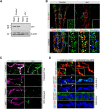

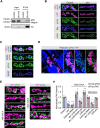
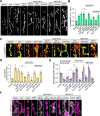

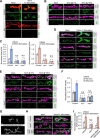
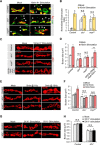
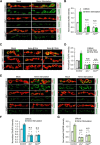

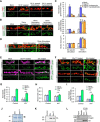
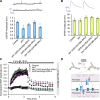
Similar articles
-
Peripheral glia and neurons jointly regulate activity-induced synaptic remodeling at the Drosophila neuromuscular junction.bioRxiv [Preprint]. 2024 Sep 13:2024.06.27.600908. doi: 10.1101/2024.06.27.600908. bioRxiv. 2024. PMID: 39005352 Free PMC article. Preprint.
-
Cortactin Is a Regulator of Activity-Dependent Synaptic Plasticity Controlled by Wingless.J Neurosci. 2017 Feb 22;37(8):2203-2215. doi: 10.1523/JNEUROSCI.1375-16.2017. Epub 2017 Jan 25. J Neurosci. 2017. PMID: 28123080 Free PMC article.
-
The B' protein phosphatase 2A regulatory subunit well-rounded regulates synaptic growth and cytoskeletal stability at the Drosophila neuromuscular junction.J Neurosci. 2006 Sep 6;26(36):9293-303. doi: 10.1523/JNEUROSCI.1740-06.2006. J Neurosci. 2006. PMID: 16957085 Free PMC article.
-
Synaptic homeostats: latent plasticity revealed at the Drosophila neuromuscular junction.Cell Mol Life Sci. 2021 Apr;78(7):3159-3179. doi: 10.1007/s00018-020-03732-3. Epub 2021 Jan 15. Cell Mol Life Sci. 2021. PMID: 33449150 Free PMC article. Review.
-
Drosophila larval neuromuscular junction: molecular components and mechanisms underlying synaptic plasticity.Microsc Res Tech. 2000 Apr 1;49(1):14-25. doi: 10.1002/(SICI)1097-0029(20000401)49:1<14::AID-JEMT3>3.0.CO;2-G. Microsc Res Tech. 2000. PMID: 10757875 Review.
Cited by
-
Fragile X Mental Retardation Protein Regulates Activity-Dependent Membrane Trafficking and Trans-Synaptic Signaling Mediating Synaptic Remodeling.Front Mol Neurosci. 2018 Jan 12;10:440. doi: 10.3389/fnmol.2017.00440. eCollection 2017. Front Mol Neurosci. 2018. PMID: 29375303 Free PMC article. Review.
-
Nonmuscle myosin II regulates presynaptic actin and neuronal mechanobiology in Drosophila.J Cell Biol. 2025 Sep 1;224(9):e202501211. doi: 10.1083/jcb.202501211. Epub 2025 Jul 11. J Cell Biol. 2025. PMID: 40644605
-
Non-muscle myosin II regulates presynaptic actin assemblies and neuronal mechanobiology in Drosophila.bioRxiv [Preprint]. 2025 Jan 26:2023.11.10.566609. doi: 10.1101/2023.11.10.566609. bioRxiv. 2025. Update in: J Cell Biol. 2025 Sep 1;224(9):e202501211. doi: 10.1083/jcb.202501211. PMID: 38014140 Free PMC article. Updated. Preprint.
-
The Tenets of Teneurin: Conserved Mechanisms Regulate Diverse Developmental Processes in the Drosophila Nervous System.Front Neurosci. 2019 Jan 30;13:27. doi: 10.3389/fnins.2019.00027. eCollection 2019. Front Neurosci. 2019. PMID: 30760977 Free PMC article.
-
Identification of secretory autophagy as a mechanism modulating activity-induced synaptic remodeling.Proc Natl Acad Sci U S A. 2024 Apr 16;121(16):e2315958121. doi: 10.1073/pnas.2315958121. Epub 2024 Apr 8. Proc Natl Acad Sci U S A. 2024. PMID: 38588427 Free PMC article.
References
Publication types
MeSH terms
Substances
Grants and funding
LinkOut - more resources
Full Text Sources
Other Literature Sources
Molecular Biology Databases
